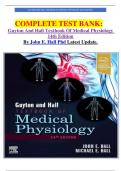Exam (elaborations)
COMPLETE TEST BANK: Guyton And Hall Textbook Of Medical Physiology 14th Edition By John E. Hall Phd Latest Update.
COMPLETE TEST BANK: Guyton And Hall Textbook Of Medical Physiology 14th Edition By John E. Hall Phd Latest Update.
[Show more]



